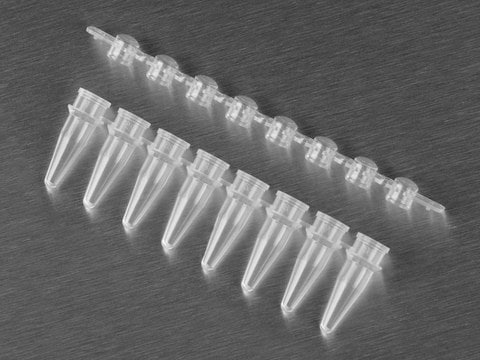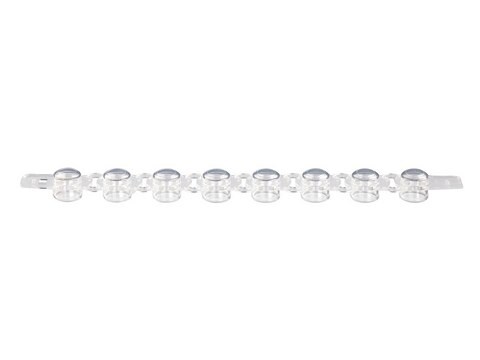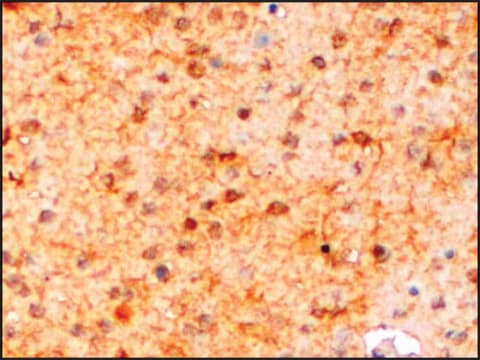一般說明
We are committed to bringing you greener alternative products, which adhere to one or more of The 12 Principles of Green Chemistry.This antibody is Preservative-free, produced without the harm or sacrifice of animals and exceptionally stable to allow for ambient shipping and storage if needed and thus aligns with "Waste Prevention", "Designing Safer Chemicals" and "Design for Energy Efficiency".
Click here for more information.
ZooMAb® antibodies represent an entirely new generation of recombinant monoclonal antibodies.Each ZooMAb® antibody is manufactured using our proprietary recombinant expression system, purified to homogeneity, and precisely dispensed to produce robust and highly reproducible lot-to-lot consistency. Only top-performing clones are released for use by researchers. Each antibody is validated for high specificity and affinity across multiple applications, including its most commonly used application. ZooMAb® antibodies are reliably available and ready to ship when you need them.
特異性
Clone 1E4 is a ZooMAb® Rabbit recombinant monoclonal antibody that specifically detects Apoptosis-inducing factor 1 (AIF). It targets an epitope within 17 amino acids from the C-terminal half.
免疫原
KLH-conjugated linear peptide corresponding to 17 amino acids from the C-terminal half of human Apoptosis-inducing factor 1 (AIF).
應用
Quality Control Testing
Evaluated by Western Blotting in NIH3T3 cell lysate.
Western Blotting Analysis: A 1:1,000 dilution of this antibody detected AIF in NIH3T3 cell lysate.
Tested applications
Western Blotting Analysis: A 1:1,000 dilution from a representative lot detected AIF in lysates from HeLa and C6 cells and Human kidney tissue.
Affinity Binding Assay: A representative lot of this antibody bound Apoptosis Inducing Factor (AIF) peptide with a KD of 1.3 x 10-6 in an affinity binding assay.
Immunohistochemistry (Paraffin) Analysis: A 1:1,000 dilution from a representative lot detected AIF in human kidney tissue sections.
Immunocytochemistry Analysis: A 1:100 dilution from a representative lot detected AIF in HeLa cells.
Note: Actual optimal working dilutions must be determined by end user as specimens, and experimental conditions may vary with the end user
Evaluated by Western Blotting in NIH3T3 cell lysate.
Western Blotting Analysis: A 1:1,000 dilution of this antibody detected AIF in NIH3T3 cell lysate.
標靶描述
Apoptosis-inducing factor 1, mitochondrial (UniProt: O95831; also known as Programmed cell death protein 8) is encoded by the AIFM1 (also known as AIF, PDCD8) gene (Gene ID: 9131) in human. AIF is a nuclear encoded flavoprotein that is generally confined to the mitochondrial intermembrane space and functions both as NADH oxidoreductase and as regulator of apoptosis. Six isoformsi of AIF have been described that are produced by alternative splicing. Under normal conditions, a 54-residue N-terminal (transit peptide) segment is first proteolytically removed during or just after translocation into the mitochondrial intermembrane space (IMS) by the mitochondrial processing peptidase to form the inner-membrane-anchored mature form (AIFmit). Upon induction of apoptosis, it is further proteolytically processed to generate the mature form, which is confined to the mitochondrial IMS in a soluble form (AIFsol). AIFsol is released to the cytoplasm in response to specific death signals, and translocated to the nucleus, where it induces nuclear apoptosis in a caspase-independent manner. AIF also functions as an anti-apoptotic factor in normal mitochondria via its NADH oxidoreductase activity. Once released from mitochondria it translocates to the nucleus to induce caspase-independent fragmentation of chromosomal DNA. Mutations in AIF gene are linked to combined oxidative phosphorylation deficiency 6 that is characterized by psychomotor delay, hypotonia, areflexia, and muscle weakness and wasting. Defects in this gene are also known to cause Cowchock syndrome that leads to early childhood onset of a slowly progressive axonal sensorimotor neuropathy. This ZooMAbZooMAb® recombinant monoclonal antibody, generated by our propriety technology, offers significantly enhanced specificity, affinity, reproducibility, and stability over conventional monoclonals. (Ref.: Son, Y-O., et al. (2009). Apoptosis, 14(6); 796-808; Cande, C., et al. (2004). Cell Death Differ. 11(6); 591-595).
外觀
Purified recombinant rabbit monoclonal antibody IgG, lyophilized in PBS, 5% Trehalose, normal appearance a coarse or translucent resin. The PBS/trehalose components in the ZooMAb formulation can have the appearance of a semi-solid (bead like gel) after lyophilization. This is a normal phenomenon. Please follow the recommended reconstitution procedure in the data sheet to dissolve the semi-solid, bead-like, gel-appearing material. The resulting antibody solution is completely stable and functional as proven by full functional testing. Contains no biocide or preservatives, such as azide, or any animal by-products. Larger pack sizes provided as multiples of 25 μL.
重構
300 μg/mL after reconstitution at 25 μL per vial. Please refer to guidance on suggested starting dilutions and/or titers per application and sample type.
儲存和穩定性
Recommend storage of lyophilized product at 2-8°C; Before reconstitution, micro-centrifuge vials briefly to spin down material to bottom of the vial; Reconstitute each vial by adding 25 μL of filtered lab grade water or PBS; Reconstituted antibodies can be stored at 2-8°C, or -20°C for long term storage. Avoid repeated freeze-thaws.
法律資訊
ZooMAb is a registered trademark of Merck KGaA, Darmstadt, Germany
免責聲明
Unless otherwise stated in our catalog or other company documentation accompanying the product(s), our products are intended for research use only and are not to be used for any other purpose, which includes but is not limited to, unauthorized commercial uses, in vitro diagnostic uses, ex vivo or in vivo therapeutic uses or any type of consumption or application to humans or animals.








